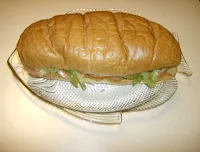
- 1 lb. dry red kidney beans (large or small)
- 2 medium onions, chopped
- 6 cloves garlic, crushed and chopped
- 3 ribs celery, chopped
- 1 cup chopped bell pepper
- 2 tsp Colgin liquid smoke
- choice of meats (sausages, smoked ham hocks, bacon, or salt pork)
- water (enough to fill your crock-pot to about 1/2" from the rim after first adding all the other ingredients).
- salt and season to taste (cayenne pepper, black pepper, basil, thyme, etc.)
Try to acquire dried red beans which are less than 6 months old. You can either soak the red kidney beans over night for absorption, or you can bring them to a quick boil on the stove for a few short minutes, remove them from the heat source, cover and wait 1 hour, and get basically the same results. Drain and rinse under warm water.
Add all the above ingredients in a 5 quart crock-pot (except for the salt) and slow-cook for several hours--until the meat and beans are tender enough to eat. Stir occasionally without bruising the beans. This is a simple recipe, yet one which is delicious over cooked long-grain white rice.
If you are going to use meats which are cured with salt (such as salt pork), you can expect a little longer cooking time and less tender beans. For absolutely great taste use andouille sausage if you can find it at your local grocer. If not, you may be able to find it online, or substitute a good smoked sausage made of beef and pork. Yum! (C'est Bon)... Enjoy!






